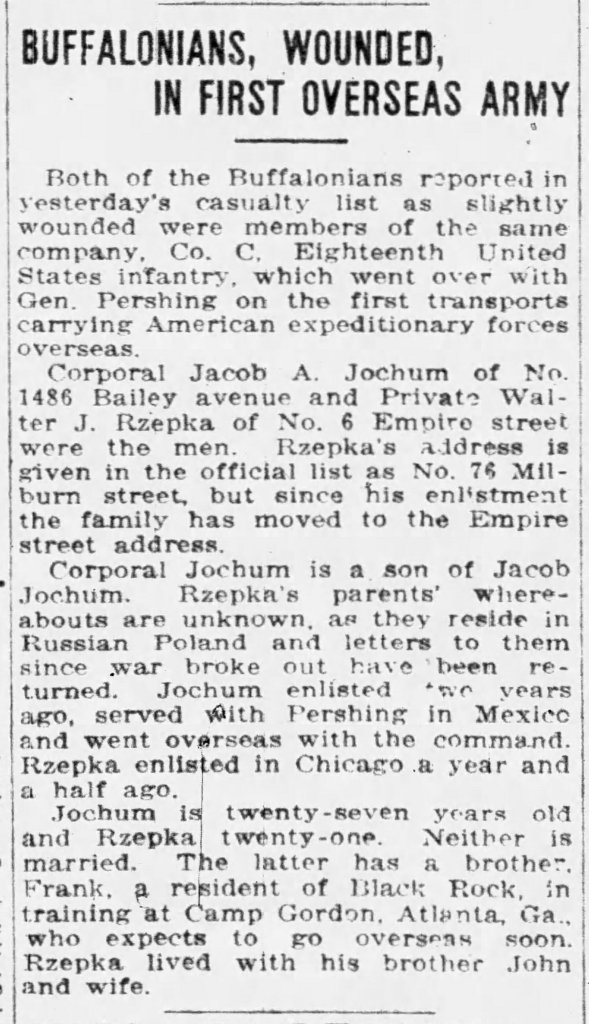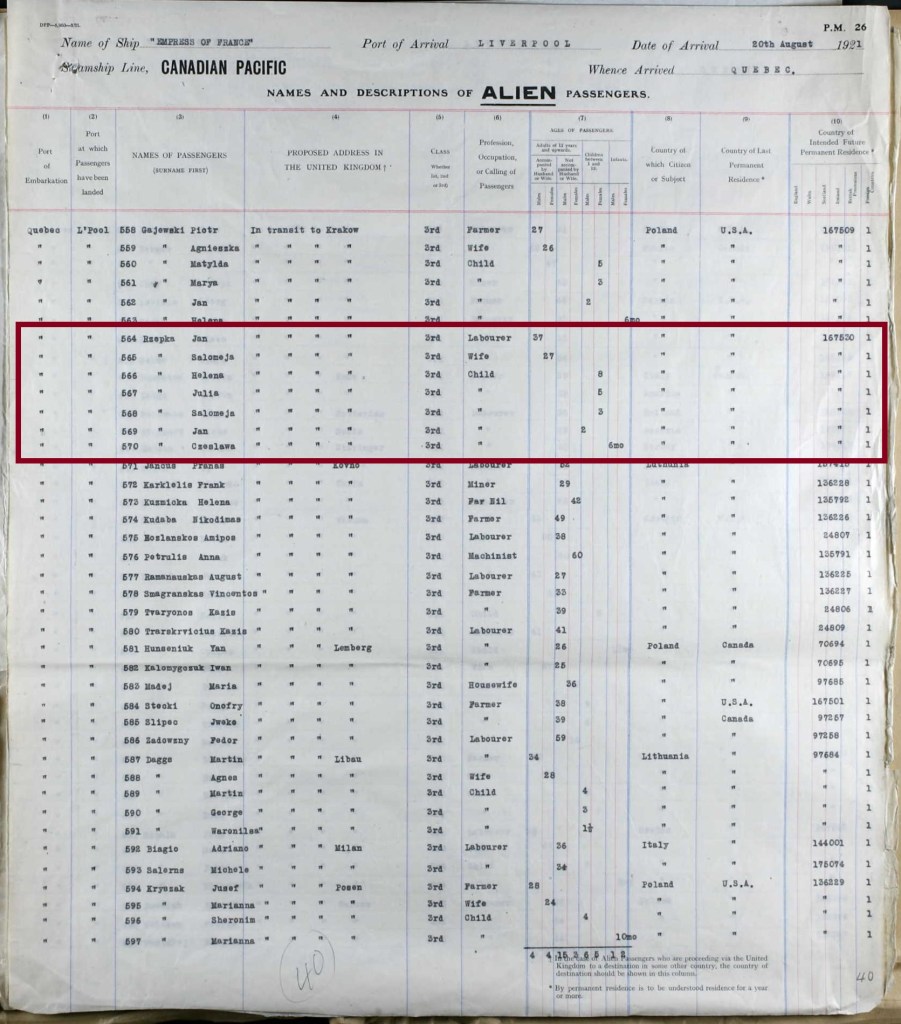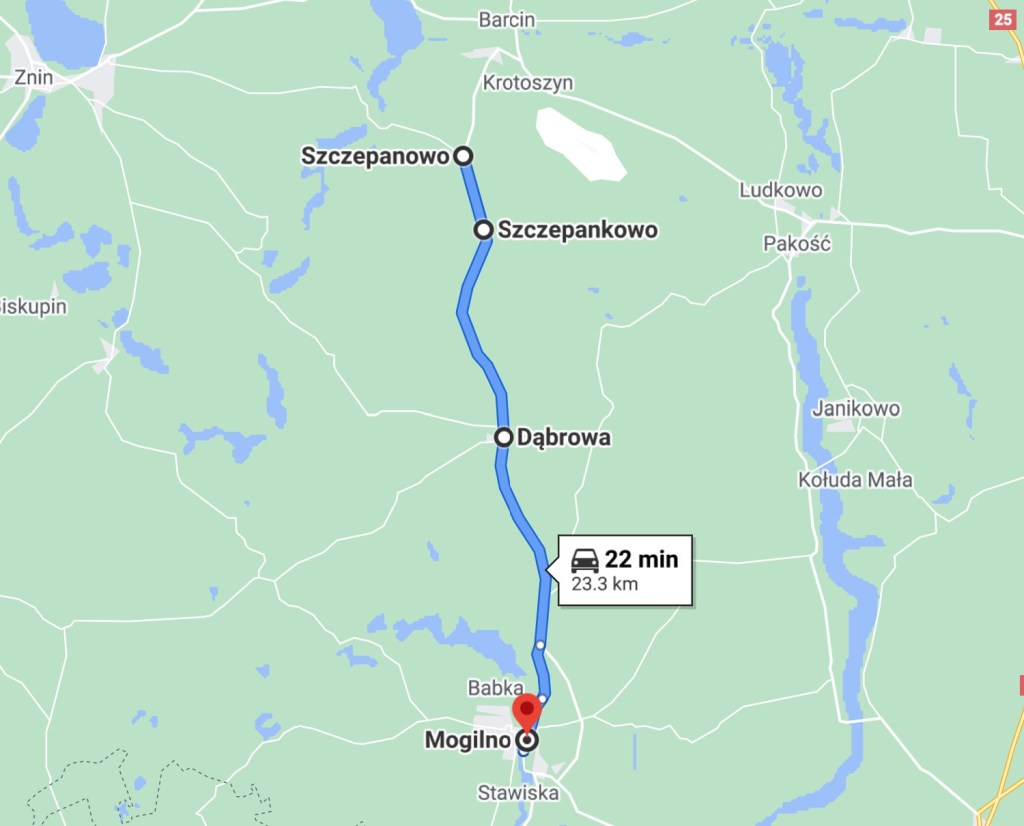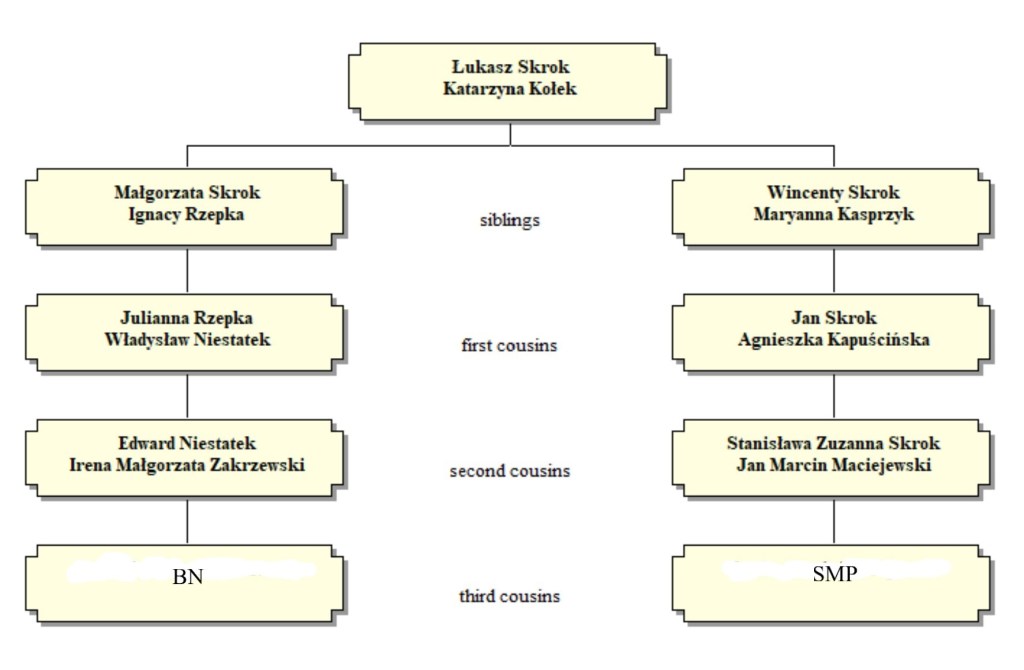Rzepka Family Moved to Szczepankowo, Dąbrowa, Mogilno, Bydgoszcz
“Rzepka’s family whereabouts are unknown, as they reside in Russian Poland and letters to them since war broke out have been returned.”
Buffalo Courier, 17 May 1918
Something was wrong.
Between 1906 and 1913, many of the children of Ignacy Rzepka and Małgorzata Skrok, their cousins Jan and Stanisława Skrok, as well as other relatives, had left their little village of Kaliszany near Opatów in the Radom province of Russian Poland and made their way to America. Son-in-law Józef Szczepański came about 1906, followed by his wife Marianna Rzepka Szczepańska with their daughter Anna Stefania. Marianna‘s brothers–Stanisław, Jan, Franciszek, and Władysław Rzepka–came to America by 1913.
The Great War started in 1914. Władysław (Walter) Rzepka joined the United States Army in Chicago on 1 Mar 1917. The United States declared war on 6 April 1917, and Walter Rzepka was sent out with the Co. C. Eighteenth United States infantry on the first transports carrying American expeditionary forces overseas under General Pershing.
Walter Rzepka was one of the United States casualties of the war. Slightly wounded, this Buffalo Courier article reported that “Rzepka’s family whereabouts are unknown, as they reside in Russian Poland and letters to them since war broke out have been returned.”
In the “History of Poland during World War I,” Wikipedia offers an overview
While Poland did not exist as an independent state during World War I, its geographical position between the fighting powers meant that much fighting and terrific human and material losses occurred on the Polish lands between 1914 and 1918.
When World War I started, Polish territory was split during the partitions between Austria-Hungary, the German Empire and the Russian Empire, and became the scene of many operations of the Eastern Front of World War I.
In the aftermath of the war, following the collapse of the Russian, German and Austro-Hungarian Empires, Poland became an independent republic.
Excerpt, “History of Poland during World War I,” Wikipedia
Much of the heavy fighting on the war’s Eastern Front took place on the territory of the former Polish state. In 1914 Russian forces advanced very close to Kraków before being beaten back. The next spring, heavy fighting occurred around Gorlice and Przemyśl, to the east of Kraków in Galicia. In 1915 Polish territories were looted and abandoned by the retreating Imperial Russian army, trying to emulate the scorched earth policy of 1812; the Russians also evicted and deported hundreds of thousands of its inhabitants suspected of collaborating with the enemy. By the end of 1915, the Germans had occupied the entire Russian sector, including Warsaw. In 1916 another Russian offensive in Galicia exacerbated the already desperate situation of civilians in the war zone; about 1 million Polish refugees fled eastward behind Russian lines during the war.
Excerpt, “History of Poland during World War I,” Wikipedia
Engagement of Opatów-Klimontów
The Radom area near Sandomierz was heavily impacted by the war, with fighting among the Russian, German, and Austria-Hungary Empires.
To face the threat from Silesia, the Russians withdrew men from East Prussia and from the front facing the Austro-Hungarians The geographical barrier that separated the bulk of the opposing armies was the Vistula River. The Russian corps marching north to fill the gap moved along the east bank of the Vistula, which protected their left flanks. The troop movements involved both the Southwest Front commanded by Nikolay Iudovich Ivanov and the Northwest Front under Nikolai Ruzsky. Their movements were poorly coordinated.
To guard the crossings for their Fourth and Ninth Armies, on the west bank of the Vistula the Russians deployed the 75th Reserve Division (Fourth Army) at Radom, as well as the group of General Delsalle, consisting of the Guard Rifle Brigade, 2nd Rifle Brigade and 80th Reserve Division, at Opatów-Klimontów. Both groups were screened by the Cavalry divisions of the Corps Nowikow. On 28 September German Ninth Army began a meticulously planned advance toward the Vistula River. German XI, Guard and Austro-Hungarian I Corps marched in heavy rain toward Delsalle’s group. Because German Army wagons were too heavy for the woeful Polish roads, submerged in several feet of mud, they used light Polish carts hired along with their peasant drivers. As they advanced they improved the roads and bridges so they could support heavy artillery and adjusted the rails to the narrower European gauge. (The Vienna-Warsaw line was already European gauge.) Explosives were cached at road and railway bridges so they could be destroyed if necessary.
On 6 October, Dankl’s First Army cavalry had reached Sandomierz, and though the Russians lost 7000 of General Delsalle’s infantry killed or taken prisoner near Opatów, the remaining forces had withdrawn across the Vistula. On 7 October, Archduke Joseph Ferdinand‘s Fourth Army captured Rzeszów, while Svetozar Boroević‘s Third Army advanced towards Przemyśl. On 11 October, Austro-Hungarian troops captured Jarosław, and 5000 prisoners, but once, again, the Russians were able to withdraw across the San River.
Engagement of Opatów-Klimontów, “Battle of the Vistula River,” Wikipedia
Much of the fighting of the Opatów-Klimontów engagement was in the area where my grandparents were born and lived as children. My grandfather Jan Skrok, his sister Stanisława Skrok, as well as their Rzepka cousins, were born in Kaliszany. My grandmother Agnieszka Kapuścińska and her siblings were baptized in Koprzywnica. The Wiśła (Vistula) and San Rivers meet near Sandomierz.

Skrok, Kiec, Kwiatek Families Returned to Poland
My grandparents went back to Poland in 1920, along with the Kiec and Kwiatek families. Possibly because of the devastation of their hometowns, they took up residence in Sosnowiec, in the western edge of the Kielce Voivodeship. That was where my uncle and his cousins were born, before my grandparents and the Kiec families returned to Buffalo, Erie, New York in the 1920s. My great-grandmother’s Kwiatek family remained in Będzin, Poland. American born Leo Kwiatek was found in the Arolsen Archives on a list of Bendsburg (German for Będzin) and other detainees in Selb, Bayern, Germany, from 28 May 1942–19 Jun 1942. It is not known what happened to him and other family members during and after World War II.


Leo’s sister Aniela Kwiatek Jankowska wrote to Buffalo in 1947, and the letter was passed on to my grandmother and found in her papers.
Jan Rzepka Family Returned to Poland
Czesława “Leona” Rzepka, the youngest daughter of Jan Rzepka and Salomea Zielińska was born in Buffalo 22 March 1921, so she was a baby when her family returned to Poland. They traveled on the ship Empress of France, traveling from Quebec to Liverpool, and arriving 20 August 1921.
It is not clear what prompted the trip. Salomea had immigrated to the United States as a baby with her family. Did they go to Poland to see Jan‘s family?
Jan Rzepka returned to Buffalo on the ship President Adams sailing from London on October 31st, 1923. His last permanent address was listed as Szczepankowo, Poland, and he left behind his wife, Salomea Rzepka, in Szczepankowo, Dąbrowa.

“Jan Rzepka’s Wife and Children Returned to America in 1925” on the ship America sailing from Bremen August 5th, 1925, arriving at the Port of New York August 15th, 1925. The children–Helena, Julianna, Florentyna, Jan, and Leona–were American citizens, going to their father, John Rzepka, at 152 Townsend Street, Buffalo, New York.
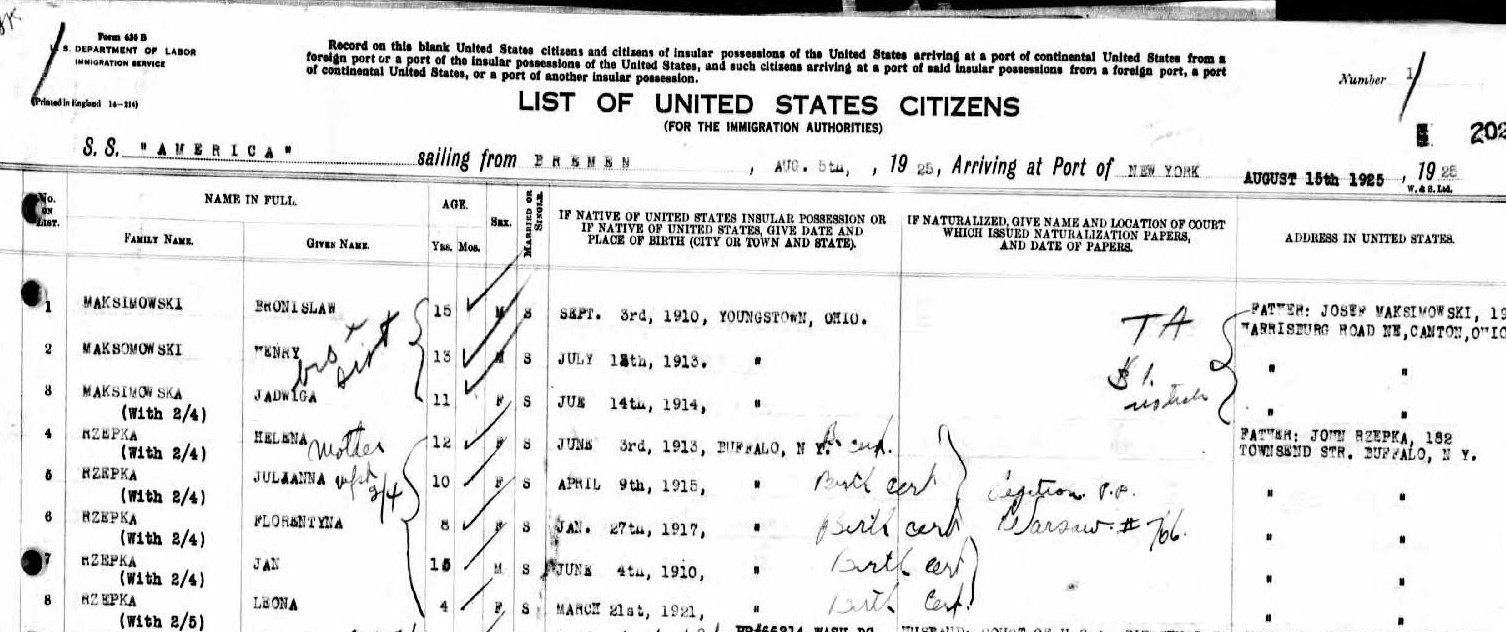
They were traveling with their Polish born mother, Salomeja Rzepka.

Salomeja‘s last permanent address was listed as Szczepankowo, Mogilno, Poland, and the person she was leaving behind was her mother-in-law, Magdalena [sic] Rzepka. This is interesting because prior to World War I, Szczepankowo, a village in the Dąbrowa area of Mogilno, had been in Posen, Prussia. It became part of Poland when the Second Republic of Poland was formed after the war. Szczepankowo is currently in the Kuyavian-Pomeranian Voivodeship in north-central Poland.
I was confused about Szczepankowo and Szczepanowo, but learned the two villages were very close to one another.
Rzepka Family Moved to Szczepankowo, Dąbrowa, Mogilno, Bydgoszcz, Poland
The Rzepka family moved 330 kilometers (more than 200 miles) from Kaliszany, Opatów, in the former Russian province of Radom to Szczepankowo, Dąbrowa, Mogilno, Bydgoszcz, Poland.

Julianna Rzepka
Julianna Rzepka, daughter of Ignacy Rzepka and Małgorzata Skrok, was born 18 Jan 1900 in Kaliszany, Wojciechowice, Opatów, Radom, Congress Poland, Russia.

The note in the margin says that Julianna Rzepka married Władysław Niestatek on 17 May 1922 in Szczepanowo. Parafia pw. św. Bartłomieja, the Church of Saint Bartholomew in Szczepanowo, is the parish church of Szczepankowo.
Edward Niestatek
After World War II, Władysław and Julianna Niestatek‘s son, Edward Niestatek, was displaced and immigrated to America. His resettlement form listed his uncle John Rzepka on Upton Road in Batavia, New York.

Edward Niestatek applied for a Social Security number in the United States, identifying his parents as Władyslaw Niestatek and Julia Rzepka, and his place of birth as Szczepankowo, Poland.
Name: Edward Niestatek
United States Social Security abstract, Edward Niestatek
SSN: 123260953
Gender: Male
Race: White
Birth Date: 25 Aug 1926
Birth Place: Szczepankowo, Poland
Father Name: Wladislaw Niestatek
Mother Name: Julia Rzepka
Death Date: 1 Oct 1988
Death Certificate Number: 163912
Type of Claim: Original SSN.
Notes: Jun 1950: Name listed as EDWARD NIESTATEK
Edward Niestatek then moved to California, where he married Irena Małgorzata Zakrzewska in Los Angeles on 19 Jun 1960. Edward and Irena Niestatek had two children, raised in Santa Monica. Edward Niestatek died in Orange County, California on 1 October 1988, and was buried in Holy Cross Cemetery in Culver City, Los Angeles, California.
In the 1990s, I was told Edward Niestatek was a Rzepka relative and I corresponded with his son B. Niestatek in California. His grandmother Julianna Rzepka Niestatek and my grandfather Jan Skrok were first cousins, so B. Niestatek and I are third cousins.
Putting the Pieces Together
It was a combination of events that made sense of this story. The American military service of Rzepka sons, the history of carnage of World War I, the travels of family members after the war, the note on the 1900 birth record that Julianna Rzepka had married in Szczepanowo, the records of Julianna‘s son in Europe and the United States, as well as family lore showed that the Rzepka family moved to Szczepankowo, Dąbrowa, Mogilno, Bydgoszcz, during or after World War I.
Update January 2023 – Added 1921 ship manifest
Sources
- Wikipedia contributors, “History of Poland during World War I,” Wikipedia, The Free Encyclopedia, https://en.wikipedia.org/w/index.php?title=History_of_Poland_during_World_War_I&oldid=1016652502 (accessed May 23, 2021).
- Wikipedia contributors, “Battle of the Vistula River,” Wikipedia, The Free Encyclopedia, https://en.wikipedia.org/w/index.php?title=Battle_of_the_Vistula_River&oldid=1006012175 (accessed May 23, 2021).
- Towarzystwa Genealogicznego Polski, Wojciechowice, 1883 18, Ignacy Rzepka Stanisław, Jadwiga Młynek? Małgorzata Skrok Łukasz, Katarzyna Kołek; digital images, Towarzystwa Genealogicznego Centralnej Polski (http://metryki.genealodzy.pl : accessed 26 May 2019).
- Genbaza, “Genbaza,” database, Polish Genealogical Society, Genealodzy (Metryki.GenBaza.pl: accessed 19 November 2019), Jozef Szczepanski Maryanna Rzepka; citing Urząd Stanu Cywilnego (Civil Registry Office).
- Geneteka, 1903 33 Józef Szczepański Michał, Józefa Stępień Marianna Rzepka Ignacy, Małgorzata Skrok Wojciechowice.
- “Passenger Lists,” database, The Statue of Liberty – Ellis Island Foundation, Ellis Island (www.libertyellisfoundation.org: accessed 2010), Stanislaw Rzepka on Ship Finland. arrived New York 30 April 1912; citing ship manifests.
- Petition for Naturalization (7 Nov 1960).
- Geneteka, 1890 95 Jan Rzepka Ignacy Marianna Skrok Wojciechowice.
- Metryki, https://metryki.genealodzy.pl/metryka.php?ar=7&zs=0848d&sy=151&kt=3&skan=095-100.jpg.
- Geneteka, 1893 41 Franciszek Rzepka Ignacy Małgorzata Skrok Wojciechowice.
- Genealodzy, Stanisław Rzepka.
- Metryki, https://metryki.genealodzy.pl/metryka.php?ar=7&zs=0848d&sy=151&kt=6&skan=040-043.jpg.
- BUFFALONIANS WOUNDED, IN FIRST OVERSEAS ARMY, Buffalo Courier, Buffalo, New York, 17 May 1918, page 2.
- Franciszek Rzepka, Dziennik dla Wszystkich [Everybody’s Daily], Buffalo, New York, 8 August 1930, page 11.
- Frank Rzepka, Batavia, N. Y. – Domicela Bednarowska, 678 Smith, Buffalo Enquirer, Buffalo, New York, 4 January 1922, Page 3.
- Geneteka, 1896 20 Władysław Rzepka Ignacy Małgorzata Skrok Wojciechowice.
- Metryki, https://metryki.genealodzy.pl/metryka.php?ar=7&zs=0848d&sy=152&kt=3&skan=016-021.jpg.
- Buffalo Courier, 17 May 1918.
- Walter Joseph Rzepka, District of Masssachusetts, U.S. Circuit and District Courts, , Michigan; 1907-1966; National Archives and Records Administration, Washington, D. C.
- Walter J Rzepka, New York, U.S., Abstracts of World War I Military Service, 1917-1919, 1 March 1917; Military Records; ; , Albany, New York.
- “Ancestry Passenger Lists,” database, Ancestry (ancestry.com: accessed 25 March 2019), Maryanna Kwiatek; citing Passenger Lists.
- Ancestry, Maryanna Kwiatek.
- “UK, Incoming Passenger Lists, 1878-1960,” digital images, Ancestry.com (http://ancestry.com : accessed 14 December 2015), Kwiatek.
- “Polskie Towarzystwo Genealogiczne,” database, Polish Genealogical Society, Geneteka (geneteka.genealodzy.pl: accessed 2015), 1887. Kaliszany. Skrok Wincenty and Maryanna Kasprzyk; citing church records or Urząd Stanu Cywilnego (Civil Registry Office).
- Genbaza, “Genbaza,” database, Polish Genealogical Society, Genealodzy (Metryki.GenBaza.pl: accessed 2 May 2020), 1902 22 Andrzej Kwiatek Wojciech, Anna Szczepaniak Marianna Skrok; citing Urząd Stanu Cywilnego (Civil Registry Office).
- Geneteka, 1889 46 Stanisław Skrok Wincenty Marianna Kasprzyk Wojciechowice.
- Geneteka, 1902 22 Andrzej Kwiatek Wojciech, Anna Szczepaniak Marianna Skrok [Inne nazwiska: Kasprzyk ] Jan, Małgorzata Bartkiewicz Wojciechowice.
- “UK, Incoming Passenger Lists, 1878-1960,” digital images, Ancestry.com, Kwiatek.
- New York State, Department of Health, Vital Records Index, Birth, Certificate Number: 42189, Lean F Kwiatek, 28 January 1914, Albany, New York.
- 1915 New York State Census, New York State, population schedule, Buffalo Ward 10, A.D. 06, E.D. 05, Erie, New York, 40, 19, Kwiatek.
- “Arolsen Archives,” digital images, International Center on Nazi Persecution (https://arolsen-archives.org : accessed 26 October 2020), Leo Kwiatek; Selb (Oberfranken) 28 May 1942-19 Jun 1942.
- Geneteka, 1900 15 Julianna Rzepka Ignacy Małgorzata Skrok Wojciechowice.
- Metryki, Julianna Rzepka.
- “Arolsen Archives,” digital images, International Center on Nazi Persecution (https://arolsen-archives.org : accessed 1 June 2021), Edward Niestatek.
- Social Security Administration, “U.S. Social Security Death Index,” database, Social Security Applications and Claims (online : accessed December 2015), Edward Niestatek, 123260953, June 1950.

